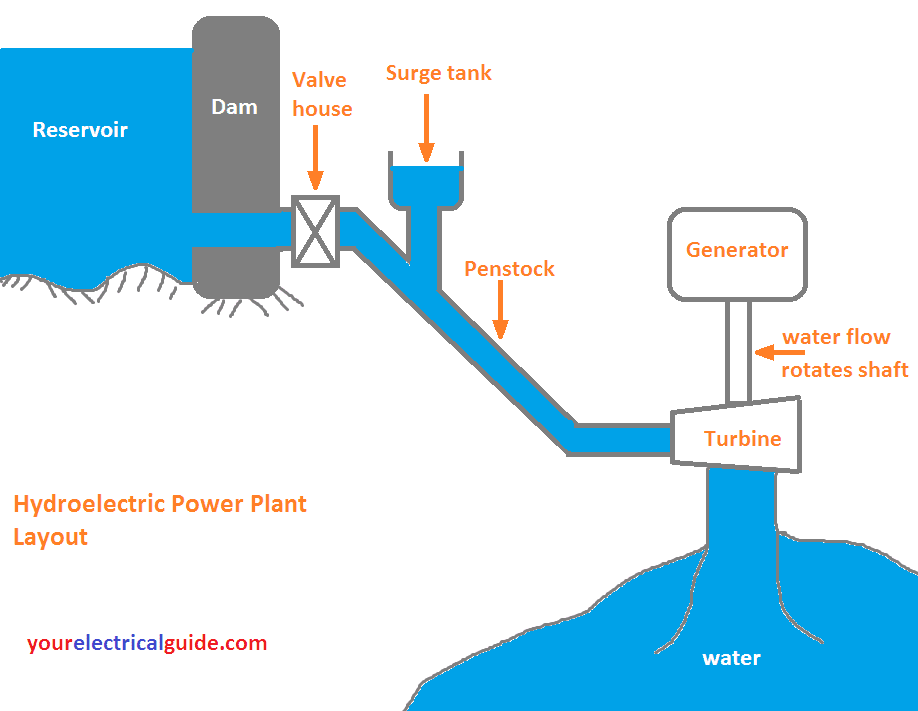Working Principle of Hydroelectric Power Plant
A power plant that utilizes the potential energy of water for the generation of electrical energy is known as a hydroelectric power plant.
Hydroelectric power plants are generally located in hilly areas where dams can be built easily, and large water reservoirs can be made. In a hydropower plant, a water head is created by building a dam across a river or lake. From the dam, water is fed to a water turbine.
Working Principle of Hydroelectric Power Plant
The water turbine changes the kinetic energy of the falling water into mechanical energy at the turbine shaft. In simple words, falling water spins the water turbine. The turbine drives the alternator coupled with it and converts mechanical energy into electrical energy. This is the basic “working principle of hydroelectric power plant.”
Hydroelectric power plants are very popular because the stores of fuels (i.e., oil and coal) are exhausting day by day. They are also beneficial for irrigation and flood control purposes.

Elements of Hydroelectric Power Plant
The main elements of a hydroelectric power plant are as follows:
Catchment area: The total area behind the dam in which water is collected and stream-flow is obtained is known as the catchment area.
Reservoir: It is an integral part of the power plant, where water is stored and supplied to a water turbine continuously.
Dam: A dam is a barrier that stores water and creates a water head.
Slip-way: Due to heavy rainfall in the catchment area, the water level may exceed the storage capacity of the reservoir. It may affect the stability of the reservoir.
A structure is formed around the reservoir to remove this excess water. This structure is known as slip-way. Slip-way provides stability to the reservoir and reduces the level of water in the time of the flood.
Surge Tank: It is a small tank (open at the top). It is provided to reduce the pressure surges in the conduit. It is located near the beginning of the conduit.
Penstocks: Penstocks are open or closed conduits that carry water to the turbines. They are generally made of RCC or steel. The RCC penstocks are suitable for low water heads (< 30 m). The steel penstocks are ideal for any head, as they can be designed according to water head or working pressure.
Water turbines: It works as an energy conversion device. It is a machine through which the potential energy of water is converted into the mechanical energy of shaft. The main types of water turbines are:
(i) Impulse turbines (ii) Reaction turbines
Impulse turbines: Such turbines are used for high water heads. It consists of a wheel fitted with elliptical buckets along its periphery. The whole pressure of water is converted into kinetic energy in a nozzle, and the velocity of the jet spins the wheel — for example, the Pelton wheel turbine.
Reaction turbines: The important types of reaction turbines are:
(a) Francis turbines (b) Kaplan turbines
A Francis turbine is used for low to medium heads. A Kaplan turbine is used for low heads and large quantities of water.
Water Turbine Generators: They are low RPM (75 to 300) synchronous generators with main exciters usually mounted at the top on the shaft end. The machines are generally air-cooled with closed-circuit cooling.
Power House Auxiliaries: The hydroelectric power plant requires the same basic auxiliaries as any other power plant such as the governor system, exciters, cranes, control panels, etc. Power supply for the auxiliaries, cranes, and lighting is usually arranged from a small independent hydraulic turbine and generator.
Hydroelectric Power Plant Advantages
- More reliable power plant.
- Low operating cost.
- Low starting time.
- High production rate capacity.
- The fuel cost is zero.
- Pollution-free.
- Renewable source of energy.
- Life of the power plant is more.
- They are also used for flood control and irrigation.
Hydroelectric Power Plant Disadvantages
- Capital cost is high.
- Output depends upon the availability of water.
- Commonly found in hill-areas.
- Apparatus needs corrosion protection.
Related Post: Hydroelectric Power Plant Working
You may also like —Power System MCQ With Answers.
Thanks for reading about the “working principle of hydroelectric power plant.” For more details, visit Wikipedia.
This helped me with my project for school.